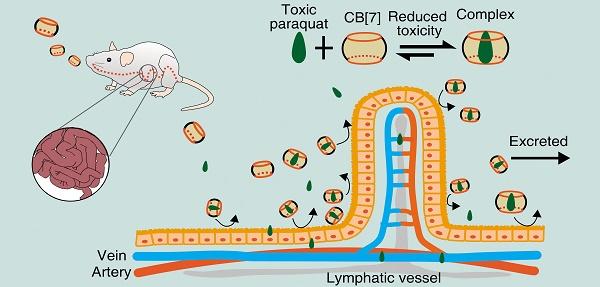Researchers at the Spanish National Research Council (CSIC) Institute for Advanced Chemistry of Catalonia (IQAC-CSIC) have discovered and synthesized a number of molecules that inhibit the effects of heparin, the most commonly used anticoagulant for treating patients at risk of thrombi. It can sometimes be essential to block the activity of heparin, for example, when patients face surgical interventions to avoid uncontrolled bleeding. Tests in mice with two of the new heparin antidote molecules generated promising results, which the researchers suggest could be the first step on the road to drug design.
Ignacio Alfonso, PhD, Daniel Carbajo, PhD, and colleagues described their development in theJournal of Medicinal Chemistry, in a paper titled, “Dynamic Combinatorial Optimization of In Vitro and In Vivo Heparin Antidotes,” in which they reported, “… both ex vivo and in vivo blood coagulation assays with mice show that the optimized molecules are potent antidotes with potential use as heparin reversal drugs.”
Heparin is used widely as an anticoagulant, but also as an antiviral and anticancer agent, the authors noted. The drug has more recently been used to help prevent clots in coronavirus patients, and in pregnant women. However, in cases of overdose, life-threatening bleeding, or high-risk surgery, clinicians will ideally have access to effective heparin reversal agents. “Although it is one of the most common anticoagulant drugs, it is not free of dangers, and it is essential to have an efficient and varied battery of antidotes,” said Alfonso. “Heparin treatment is very common in patients at risk of blood clots. However, in some cases there are allergic reactions or overdose, which cause the appearance of significant bruising or even uncontrolled bleeding … This is especially critical in patients under heparin treatment who need urgent or unexpected surgery (for example, after severe trauma or a cardiovascular accident). In these cases, the inhibition of circulating heparin in the bloodstream is essential to avoid complications due to excessive bleeding.”

Protamine sulfate is currently the antidote used to neutralize the action of heparin, but it is a high molecular weight drug, so it can have disadvantages. “ … considering the general drawbacks of using high molecular weight drugs, the search for alternative small molecules able to revert the anticoagulation effects of heparin is a hot topic in current research,” the researchers wrote. Yet to date, there is no small molecule on the market that inhibits the anticoagulant effect of heparin. “ … the search of heparin antidotes based on small synthetic molecules to control blood coagulation still remains a challenging task due to the physicochemical properties of this anionic polysaccharide,” the authors continued.
In a 2018 publication inAngewandte Chemie International Edition, the researchers described the use of dynamic combinatorial chemistry (DCC) systems to identify a simple molecule that inhibited in vitro the effect of heparin. The methodology combines the selection, identification, and preparation of molecules for a specific application in a single process, accelerating the development of new functional compounds. “Dynamic covalent chemistry does not require detailed knowledge of the structural characteristics of the target since the target itself selects and amplifies the most efficient binders from a dynamic combinatorial library (DCL) of potential ligands,” they explained in theJournal of Medicinal Chemistry paper.
The limited structural information and the heterogeneity of the heparin molecule make it a good candidate as a model in dynamic combinatorial chemistry, since this methodology does not require detailed knowledge of the structure of the target molecule. For their newly reported work Alfonso and colleagues applied the same DCC approach for a broader screening, and this led to the discovery of new molecules with greater potential as heparin antidotes.
“In this work, we expand the molecular diversity of the dynamic library, thus generating a much wider molecular recognition space,” the team further noted. This library, they said, better covers the structural basis for the efficient recognition of heparin, and identifies more potent binders with potential applications as drugs. “Moreover, the larger structural diversity allows the validation of the dynamic combinatorial chemistry approach to the development of potent hits, by correlating the response in the dynamic covalent screening with the activity in blood coagulation.”
The new study identified promising heparin antidote compounds. Alfonso commented, “… an excellent correlation between screening results and heparin inhibition has been found with in vitro enzymatic assays, from which a small collection of molecules with good activity was obtained.” From the resulting compounds, two—designated 3FF and 3AC—showed significantly better in vitro activities than those obtained in the research reported in 2018, and were tested in vivo, generating excellent results. “The results clearly show that both 3FF and 3AC are efficient antidotes of Hep also in vivo, strongly reducing the bleeding of heparinized mice,” the investigators stated.
Alfonso concluded, “This study represents a definitive validation of our approach.” The reported results underscore the power of dynamic combinatorial chemistry targeting complex and elusive biopolymers, the team believes, and represents an “extremely convenient” screening protocol to identify strong binders to elusive biomacrmolecules. “Thus, the dynamic combinatorial screening demonstrates to be a very powerful tool for the discovery of new hits in the development of future drugs where conventional approaches have found many difficulties to succeed.”
